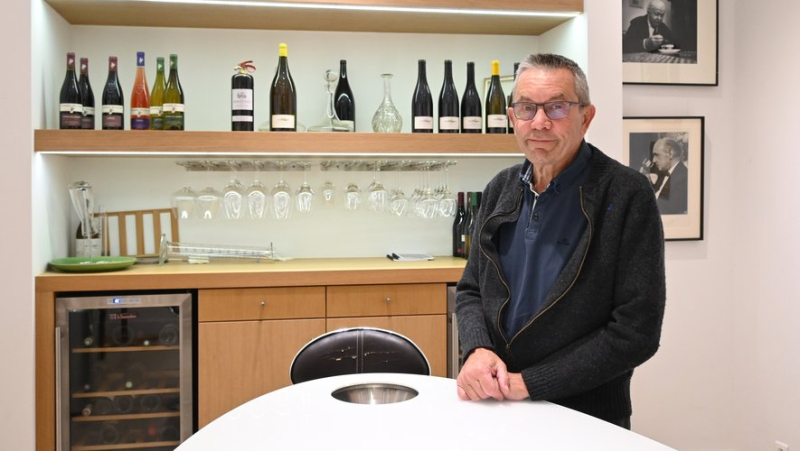“Being recognized as a vintage is very rare!”, the culmination of a long story for the president of the Laudun wine union Luc Pélaquié

Luc Pélaquié est le président du syndicat des vins de Laudun. C.B.
Luc Pélaquié, président du syndicat des vins de Laudun, revient sur le passage en cru des vins de l’appellation. C’est le troisième cru des Côtes-du-Rhône dans le Gard.
The Laudun appellation is now a cru… How long have you been working there ?
It is the culmination of a long history! In 1945, a group of winegrowers including my grandfather had already had the idea of making a cru, they fought for the recognition of Laudun wines. In 1958, the Inao (National Institute of Appellations of Origin) accepted the name Côtes-du-Rhône Laudun, then in 1967, when the AOC (controlled designation of origin) Côtes du Rhône villages was created by decree, Laudun returned to this family. At the time, a file was put together to become a cru, but it was not accepted. And a dozen years ago, we considered reapplying for the vintage for Laudun. For ten years, the winegrowers agreed to make efforts. It was necessary to tighten the plot area. And finally, in September, we obtained the vintage for all the winegrowers of the Laudun appellation. This represents a hundred winegrowers in three villages: Laudun, Tresques, Saint-Victor-la-Coste.
What does this represent for you as a winegrower and as president of the Laudun wine union ?
It makes me very happy. We are reaching the goal that my grandfather set for himself. I have been president for 30 years, my grandfather was for 31 years… This achievement is a collective effort with all the winegrowers. It is up to the winegrowers to bring their vintage to life.
Laudun thus enters the very closed circle of crus…
Being recognized as a cru is rare! There are now three in the Gard, with Tavel, a cru since 1936, and Lirac, a cru since 1947. We must not forget that the right bank of the Rhône is the cradle of the Côtes-du-Rhône. A cru is an appellation of controlled origin (AOC) with a name. The protected designation of origin, which depends on Europe, will follow.
What does it change for winegrowers to be in cru ?
It allows you to manage your appellation, your specifications. When you are a Côtes-du-Rhône village – there are 22 from Domazan to Nyons, spread over two regions – with different problems – you can't do it, it's uniform. There is another advantage: when you sell wine, there is a tax called the CVO (compulsory voluntary contribution). Until now, it was paid into the budget in the Côtes-du-Rhône village section, now this CVO will be reserved for the promotion of Laudun.
When will we see the first bottles of the Laudun vintage ?
We have the vintage for the 2024 harvest so we will have the whites at the beginning of the year, around February. For the red, it is desirable that it is not before the end of 2025. We will present the appellation at the Wine Paris show next February. With the support of Inter Rhône (the inter-union of Côtes-du-Rhône wines in the Rhône Valley), we are going to change our image, our logo…
Some plots do not fall within the delimitation of the cru… How does this happen ?
On the plots that have not been selected as cru, we can make Côtes-du-Rhône villages, without the name of the commune. This concerns off-center plots. The vintage concerns 1,150 hectares, the Laudun villages appellation was about 3,000 hectares.
Does becoming a vintage necessarily lead to an increase in the price of bottles ?
We must remain reasonable on prices, compared to the usual customers of Laudun wines. With the quality of a vintage, we will also have another clientele.
How are the harvests going that are not yet finished ?
There is a huge loss of yield overall. Mildew has affected the vineyard, as has hail. On our estate, the harvest will last until mid-October. The harvest is getting earlier and earlier, but this year it started at the end of August, beginning of September, at a normal date. When I started, years ago, the grape harvest was not until early October…
Ten crus in the southern vineyards of the Rhone Valley
The southern vineyards of the Rhone Valley now include ten crus: Châteauneuf-du-Pape, Gigondas, Vacqueyras, Rasteau, Beaumes-de-Venise, Lirac, Tavel, Vinsobres, Cairanne and Laudun.
The part The northern part of the vineyard has eight appellations classified as crus: Côte-Rôtie, Condrieu, Château-Grillet, Crozes-Hermitage, Hermitage, Cornas, Saint-Joseph, Saint-Péray.
I subscribe to read the rest




